- Tutorials
- Stances ( 서기 sogi )
- Front Stance ( 앞굽이 ap-kubi )
Taekwondo 태권도Taekwondo Preschool
When you reach senior belt you are expected to guide the junior belts when they are beginning Taekwondo such as showing by example. To advance from one rank to the next, students typically complete promotion tests in which they demonstrate their proficiency in the various aspects of the art before a panel of judges or their teacher. View Taekwondo belt levels »


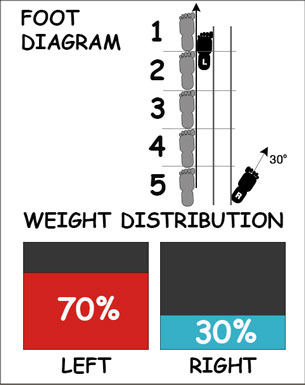


Front Stance
앞굽이 ap-kubi
Difficulty Level: Beginner Level Technique: Stance ( 서기 sogi )

Front Stance ( 앞굽이 ap-kubi ) is a precursor of the Fighting Stance ( 겨루기준비 gyeorugi-junbi ) according to some martial arts authors. Body should be relaxed in this stance ( 서기 sogi ) when performing in patterns ( 품새 poomse ) and self-defense ( 호신술 hosinsool ). Front Stance ( 앞굽이 ap-kubi ) is one of the most important techniques to learn when starting taekwondo as a beginner white belt ( 10th geup ).
To practice the Front Stance ( 앞굽이 ap-kubi ), a practitioner can begin from the Attention Stance ( 차렷 charyeot ) with feet together, one foot is then placed straight ahead of the other to form the stance ( 서기 sogi ) and repeat the step again. The hands can be placed on the waist to focus on the stance ( 서기 sogi ). Practice is the act of rehearsing a behavior over and over, or engaging in an activity again and again, for the purpose of improving or mastering it, as in the phrase 'practice makes perfect'. Depending on the martial art and style, some instructors teach to step sideways slightly when moving forward.
The distance between the inside edges or namely the reverse foot blade ( 발날등 balnaldeung ) of both feet should be between one to two fists apart and is about 4 to 4 one-half foot-length from origin. Rear toes are turned outward about 30 degrees and the body is also naturally angled at 30 degrees or facing straight forward depending on the upper body technique. The weight distribution should be 70 percent in the front and 30 percent at the back for this stance ( 서기 sogi ).
Although the specifics of the stance ( 서기 sogi ) vary by style, overall it is visually similar to a lunge, with the forward leg bent at the knee ( 무릎 mureup ), and the rear leg straight, while the hips and shoulders remain squarely facing forward. The purpose of the stance ( 서기 sogi ) is to teach musculo-skeletal alignment that adds as much mass of the earth to a strike as possible. The stance ( 서기 sogi ) allows a great deal of power generation forward, but very little in any other direction due to its weight distribution.
The Front Stance ( 앞굽이 ap-kubi ) is most commonly performed with the Front Hand Middle Punch ( 몸통 반대 지르기 momtong-bandae-jireugi ), Elbow Turning Strike ( 팔굽 돌려치기 palgup-dollyeo-chigi ), Palm Heel Forward Strike ( 바탕손 앞치기 batangson-ap-chigi ), Swallow Hand Blade Inward Strike ( 제비품 손날 안치기 jebipoom-sonnal-an-chigi ), and Supporting Vertical Thrust ( 거들어 세워찌르기 kodureo-sewo-jjireugi ) in patterns ( 품새 poomse ).
General qualities that judges look for in any taekwondo practitioner include proper breathing technique and body control. The diaphragm must be engaged in deep breathing, shallow breathing concentrated in the upper abdomen results in raised shoulders and stressed muscles. The muscles of the body should be lightly relaxed in order to perform the stance ( 서기 sogi ) with fluidity, speed and grace. Muscles should only be tensed at the moment of imaginary impact in order to commute maximum power to any individual taekwondo technique.
Training Methods
How well one improves with training depends on several factors, such as the frequency it is engaged in, and the type of feedback that is available for improvement. If a student does not train often enough, reinforcement fades, and he or she is likely to forget what was learned.
When learning the stance ( 서기 sogi ), it is helpful to use a mirror to observe your stance ( 서기 sogi ) posture and fix your mistakes immediately. Initially, a student may need focused feedback from a certified Master Instructor ( 사범님 sabeomnim ); however, as they progress, they must develop the ability to self-assess the stance ( 서기 sogi ).
Minimum Level Requirement: White Belt (10th geup)
Difficulty of Technique
Taekwondo students of geup ranking learn the most basic techniques first, and then move on to more advanced and difficult techniques as they approach 1st Dan Black Belt. The more difficult the technique, the more practice may be needed for the purpose of improving or mastering it, as in the phrase 'practice makes perfect'. Every technique must display the requisite speed, balance, power and firmness to be realistically used as an attack or defense move.
* Please see a certified Master Instructor ( 사범님 sabeomnim ) for training. Proper guidance and instructions are needed to ensure safe training.
Promotion Tests
Students often undergo periodic testing and grading by their own Master Instructor ( 사범님 sabeomnim ) in order to advance to a higher level of recognized achievement such as a different belt color. They need to demonstrate their proficiency in the various aspects of the art such as the execution of patterns ( 품새 poomse ), which combine various techniques in specific sequences.
Front Stance ( 앞굽이 ap-kubi ) is a requirement for the below belt levels (Techniques vary between schools). Promotion from one belt level to the next can proceed rapidly in some schools, since schools often allow geup promotions every two, three, or four months. Students of geup rank learn the most basic techniques first, and then move on to more advanced techniques as they approach first dan black belt. View Promotion Tests »
Advertisement
Front Stance ( 앞굽이 ap-kubi )
Footing Surface
Various surfaces of the foot may be engaged as the footing surface depending on which area of the body is being used. Proper footwork is used to enable the proper balancing of the body, to support combinations of strikes and launch strikes from the proper angle or distance. For more information on Impact Surface Areas »
( Click image for additional information)
Technique Injuries
Collisions with the ground, objects, and other taekwondo practitioners are common, and unexpected dynamic forces on limbs and joints can cause injury. Taekwondo injuries can also occur in techniques if done improperly or from overuse of a particular body part. Taking a break from training or reducing the volume and the intensity of the training will allow the body to recover. For more information on Injuries »
( Click image for additional information)
Common Mistakes when Performing the Technique
When performing the technique, there will be more mistakes as a beginner and as the practitioner advances through the rankings, they will have learned and improved from the past. How well one improves with training depends on several factors, such as the frequency it is engaged in, and the type of feedback that is available for improvement.
( Click image for additional information)
Some Techniques used in this Stance ( 서기 sogi )
An example of the union of mental and physical discipline is the combination of stance ( 서기 sogi ), footwork ( 딛기 ditgi ), and technique (either with block and/or strike), which requires both physical mastery of the technique and the concentration to focus one's power. Experienced practitioners learn through repetition and muscle memory when (not just how) to launch particular techniques, based on the circumstances they are facing.
( Click image for additional information)

Training Highlights Summary
The Stance ( 서기 sogi ) contains many key point highlights. There are some that are simple and straightforward but then some are complex and detailed that require repeated training to learn and master.
- distance between the inside edges of both feet should be between one to two fists apart
- one foot is placed straight ahead of the other about 4 to 4 one-half foot-length
- front toes facing straight forward
- rear toes are turned outward about 30 degrees
- the body is also naturally angled at 30 degrees or facing straight forward depending on the upper body technique
- weight should be 70 percent in the front and 30 percent at the back
- the arms position will depend on the technique being used
* Please see a certified Master Instructor ( 사범님 sabeomnim ) for training. Proper guidance and instructions are needed to ensure safe training.
Front Stance ( 앞굽이 ap-kubi )
Use in Sparring ( 겨루기 gyeorugi )
Under World Taekwondo (WT) and Olympic rules, sparring is a full-contact event and takes place between two competitors in an area measuring 8 meters square. A win can occur by points, or if one competitor is unable to continue (knockout) the other competitor wins. Points are awarded for permitted, accurate, and powerful techniques to the legal scoring areas; light contact does not score any points. For more information on World Taekwondo (WT) Tournament Sparring » 
( Click image for additional information)
Use in Self-Defense ( 호신술 hosinsool ) Applications
Self-Defense is to protect yourself from being attacked from would-be aggressors. It is a countermeasure that involves defending the health and well-being of oneself from harm and is designed primarily to cause injury or quickly incapacitate an attacker, in addition to being a deterrent against them. Attackers are typically larger, stronger, and are often armed or have an accomplice. With proper execution attackers may be incapacitated with a single blow, which lessens the number of attacks with multiple people. For more information on Self-Defense ( 호신술 hosinsool ) »
Practitioners must have their body weight correctly distributed during the stance ( 서기 sogi ) including proper footwork ( 딛기 ditgi ). Each technique must be correctly timed and aligned in order to defend effectively. The stance ( 서기 sogi ) is commonly performed during Self-Defense ( 호신술 hosinsool ) scenarios.
( Click image for additional information)
Use in One-Step Sparring
One-Step Sparring is performed with a partner in which predefined movements are practiced. One student is the attacker while the other student responds with defenses, counterattacks, and/or other actions, based on part of the predefined movements. For more information on One-Step Sparring »
The stance ( 서기 sogi ) is commonly featured during One-Step Sparring practice. Fundamentally, taekwondo One-Step Sparring is one of the learning grounds for real combat. As such, every technique including stance ( 서기 sogi ) must display the requisite speed, power and firmness to be realistically used as an attack or defense move. One-Step Sparring varies between schools.
( Click image for additional information)
Use in Breaking ( 격파 gyeokpa )
The discipline of destroying inanimate objects such as wooden boards, baseball bats, ice blocks or cement bricks and is a feature common to martial arts including taekwondo. A single board or stack of boards may be broken or, alternatively, a series of boards may be broken in a pre-set sequence utilizing a variety of strikes. Advanced competitors may even break several boards in a single jump with multiple kicks before landing. For more information on Breaking ( 격파 gyeokpa ) »
In use, the stance ( 서기 sogi ) is featured during Breaking ( 격파 gyeokpa ) events. General qualities that judges look for in any taekwondo practitioner include proper breathing technique and body control. The diaphragm must be engaged in deep breathing, shallow breathing concentrated in the upper abdomen results in raised shoulders and stressed muscles. Breaking ( 격파 gyeokpa ) varies between schools.
( Click image for additional information)
Advertisement
Front Stance ( 앞굽이 ap-kubi )
Use in Patterns ( 품새 poomse )
Stance is introduced in the following patterns:
BASIC PATTERN: 1
BLACK BELT: Koryo (1st Dan) Keumgang (2nd Dan) Taebaek (3rd Dan)
Poomse is the foundation for the teaching of taekwondo. A poomse or form is a detailed pattern of defense-and-attack motions and techniques used in traditional martial arts. Poomse is useful in developing proper kinetics, mental and physical fortitude.
( Click image for additional information)
Most Kukkiwon 국기원 schools will use the poomse taegeuk whereas a few schools will use the poomse palgwe. The meanings, trigrams and symbols are shared by both poomse taegeuk and poomse palgwe, however the sequence of movements is different. The first 8 forms of the set of poomse differ from each other, whereas the last 9 forms (Black Belt forms) of the set are shared between the two sets. All students studying in World Taekwondo (WT) Kukkiwon style must learn these forms, or taegeuk, to advance to a higher belt level. There are eight taegeuk forms, each one similar to the previous one, but each time with more complicated techniques to display the students' mastery of the techniques learned during lessons, as well as the ability to interconnect these techniques.
For more information on taekwondo patterns refer to Poomse 품새 Section »
Learn other taekwondo stances on the Stance ( 서기 sogi ) Section »
Practitioners must have their body weight correctly distributed during each different stance and during footwork. Each technique must be correctly aligned. Every technique must display the requisite speed, power and firmness to be realistically used as an attack or defense move.
Use in Demonstrations
To promote taekwondo for its emphasis on high kicking and fast hand techniques, taekwondo schools perform at tournaments, community events, shopping malls, parks, and tv shows. Demonstrations vary from school to school, but may include such elements as the execution of poomse ( 품새 poomse ), which combine various techniques in specific sequences; the breaking of boards to demonstrate the ability to use techniques with both power and control; sparring ( 겨루기 gyeorugi ) and self-defense ( 호신술 hosinsool ) to demonstrate the practical application and control of techniques; physical fitness usually with push-ups and sit-ups. For more information on Demonstrations »
The stance ( 서기 sogi ) is commonly used in demonstration activities such as when performing poomse ( 품새 poomse ) which is the foundation for the teaching of taekwondo. A poomse ( 품새 poomse ) is a series of movements linked together in a prescribed sequence which is significant to demonstrate. As such, every technique must display the requisite speed, power and firmness to be realistically used as an attack or defense move.
( Click image for additional information)
Use in Warming-Up
A warm-up generally consists of a gradual increase in intensity in physical activity, joint mobility exercise, and stretching, followed by the activity. Warming-up brings the body to a condition at which it safely responds to nerve signals for quick and efficient action. For more information on Warming-Up »
In addition to being a stance ( 서기 sogi ) in itself, the stance ( 서기 sogi ) is an exercise used by many instructors to teach the principle of focusing, stretching, relaxing the muscles, increasing the range of motion and flexibility, something which is considered important in taekwondo. The result is a feeling of increased muscle control, flexibility and range of motion.
Dynamic stretching increases range of movement, blood and oxygen flow to soft tissues prior to exertion. Increasingly coaches and sports trainers are aware of the role in dynamic stretching in improving performance and reducing the risk of injury. Dynamic stretching works by the practitioner gently propelling their muscles towards their maximum range of motion.
In general, the practitioner wants to move (stretch) the muscle in a similar way that they are going to move them in a workout. For example a taekwondo practitioner who wants to stretch a hamstring ( 햄스트링 haemseuteuling ) for a kick ( 차기 chagi ) may swing a straight leg forward to gradually increase the height they can obtain. Doing light kicks, with little explosive acceleration, while gradually increasing height, could also be considered a dynamic stretch. For more information on Dynamic Stretching »
Risk of injury can be reduced by completing an effective warm-up consisting of a heart raiser to get your pulse up, followed by sport specific dynamic stretches (stretches whilst moving).
( Click image for additional information)
Front Stance ( 앞굽이 ap-kubi )
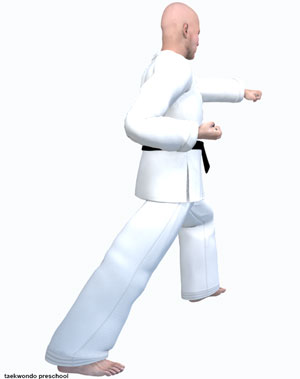
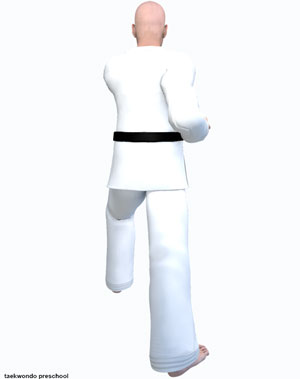

Additional Resources
Taekwondo Stances ( 서기 sogi )
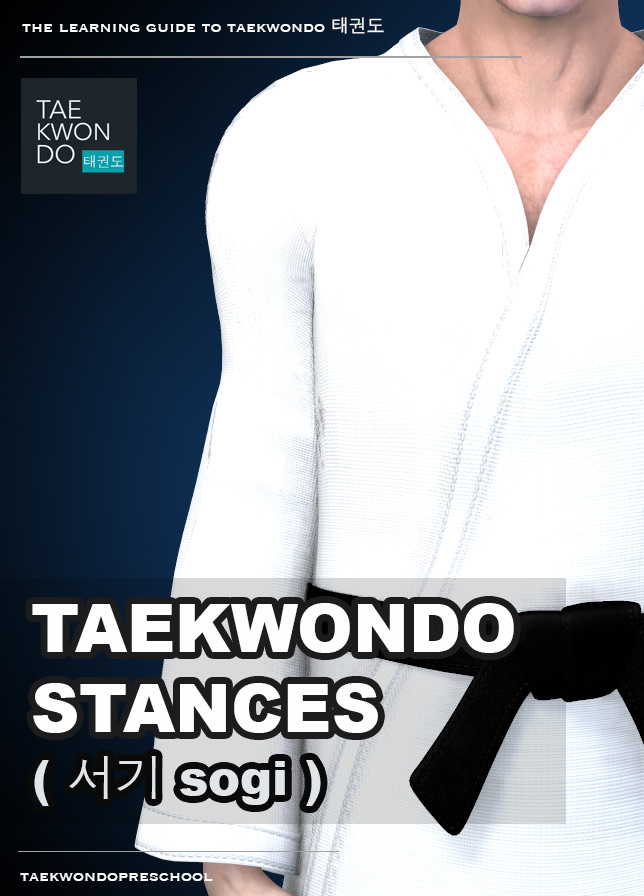
This book is available for download with Apple Books on your Mac or iOS device, and with iTunes on your computer. Book can be read with Apple Books on your Mac or iOS device.
The Korean martial arts taekwondo has several stances ( 서기 sogi ) used for different activities. Although there are strong similarities in stances ( 서기 sogi ) throughout taekwondo schools, individual instructors often have their own preferred style. These stances ( 서기 sogi ) are most commonly seen in taekwondo forms ( 품새 poomse ), and are critical for balance, precision, and good technique in the martial art.
View more information about Book »
TAEKWONDO STANCES ( 서기 sogi ) |
|||||
| Hangul 한글 | Korean | Belt Requirement | Difficulty Level | Tutorial | |
| Attention Stance | 차렷 | charyeot |   |
Beginner Level | Tutorial » |
| Ready Stance | 기본준비 | junbi |   |
Beginner Level | Tutorial » |
| Front Stance | 앞굽이 | ap-kubi |   |
Beginner Level | Tutorial » |
| Horse Riding Stance | 주춤서기 | juchum-sogi |   |
Beginner Level | Tutorial » |
| Two Fist Ready Posture | 두주먹허리준비 | dujumeok-heori-junbi |   |
Beginner Level | Tutorial » |
| Fighting Stance | 겨루기준비 | gyeorugi-junbi |    |
Beginner Level | Tutorial » |
| Walking Stance | 앞서기 | ap-sogi |   |
Beginner Level | Tutorial » |
| Parallel Stance | 나란히서기 | naranhi-sogi |   |
Beginner Level | Tutorial » |
| Inward Stance | 안쫑서기 | anjjong-sogi |   |
Beginner Level | Tutorial » |
| At Ease Stance | 편히서기 | pyeoni-sogi |   |
Beginner Level | Tutorial » |
| Back Stance | 뒷굽이 | dwi-kubi |    |
Intermediate Level | Tutorial » |
| Side Stance | 옆서기 | yeop-sogi |  |
Intermediate Level | |
| Left Stance ”L” Shape | 왼 서기 | wen-sogi |  |
Intermediate Level | Tutorial » |
| Right Stance ”L” Shape | 오른 서기 | oreun-sogi |  |
Intermediate Level | Tutorial » |
| Cross Stance | 꼬아서기 | koa-sogi |   |
Intermediate Level | |
| Rear Cross Stance | 뒤 꼬아서기 | dwi-koa-sogi |   |
Intermediate Level | Tutorial » |
| Covered Fist Posture | 보주먹준비 | bojumeok-junbi |  |
Intermediate Level | Tutorial » |
| Tiger / Cat Stance | 범서기 | beom-sogi |   |
Intermediate Level | Tutorial » |
| Forward Cross Stance | 앞 꼬아서기 | ap-koa-sogi |   |
Intermediate Level | Tutorial » |
| ‘ㅗ’ Shape Stance | ‘ㅗ’ 자 서기 | oja-sogi |   |
Advanced Level | |
| Log Pushing Hands Posture | 통밀기준비 | tongmilgi-junbi |   |
Advanced Level | Tutorial » |
| Crane Stance | 학다리서기 | hakdari-sogi |  |
Advanced Level | Tutorial » |
| Overlapped-Hand Posture | 겹손준비 | gyeopson-junbi |  |
Advanced Level | Tutorial » |
| Inner Knee Stance | 오금서기 | ogum-sogi |  |
Advanced Level | Tutorial » |
| Assisting Stance | 곁다리서기 | gyeotdari-sogi |  |
Advanced Level | Tutorial » |
Advertisement

Quiz
Question. What is the korean terminology for Attention Stance?
Attention is a stance ( 서기 sogi ) where your body is in an upright standing position with the legs side by side, heels touching, distribute 50/50 weight ratio on the left and right legs, and toes facing straight forward. Your hands should be parallel with your body, to the side as your hands tap the legs.
What is the korean terminology for Attention Stance?
Answer you gave was: ( 그만 keu-man )
Your answer is wrong! You need to study more!
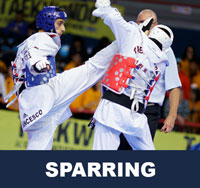

Keu-man ( 그만 ) means to stop a sparring match or poomse. Sparring is a full-contact event and takes place between two competitors in an area measuring 8 meters square. A poomse or form is a detailed pattern of defense-and-attack motions and techniques used in traditional martial arts. Poomse is the foundation for the teaching of taekwondo.
View Korean Terminology »
What is the korean terminology for Attention Stance?
Answer you gave was: ( 차렷 charyeot )
Your answer is correct! Great Job!
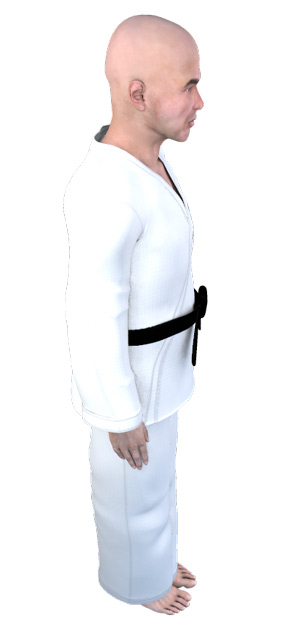

Attention is a stance where your body is in an upright standing position with the legs side by side, heels touching, toes facing straight forward. From this stance instructors explain what will be taught during the class session and/or if they want your attention they say Charyeot, meaning you stop whatever you are doing and get into the stance awaiting further instructions. This is the stance ( 서기 sogi ) that all bows ( 경례 gyeong-nye ) come from and is one of the most basic techniques to learn when starting taekwondo as a beginner.
What is the korean terminology for Attention Stance?
Answer you gave was: ( 기합 kihap )
Your answer is wrong! You need to study more!
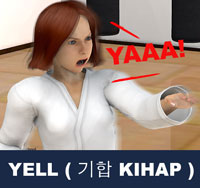

Kihap 기합 is a korean term used in taekwondo which is commonly referred to as a shout or yell made before, during, or after a technique. There are numerous examples of this battle cry in other martial arts: kihap is perhaps primarily a development of this. Students also use kihap to startle an opponent, intimidate, express confidence, or express victory in sparring competitions, self-defense ( 호신술 hosinsool ), or breaking ( 격파 gyeokpa ) applications.
View Yell ( 기합 kihap ) »
What is the korean terminology for Attention Stance?
Answer you gave was: ( 경례 gyeong-nye )
Your answer is wrong! You need to study more!
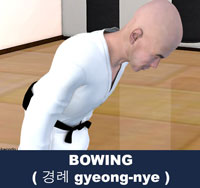

Bowing ( 경례 gyeong-nye ) is the act of lowering the torso and head as a gesture in direction to another person (Master Instructor 사범님 sabeomnim ) or symbol (flag). Bowing is an integral part of traditional martial arts such as Taekwondo. Bows are used to begin and end practice, sparring bouts and competitions, and when entering and leaving the dojang, or practice room.
Question. What year was Taekwondo an official Olympic Demonstration Sport in Seoul, Korea?
Taekwondo made its first appearance at the Summer Olympic Games as a demonstration sport at the Summer Olympics in Seoul, South Korea. The opening ceremony featured a mass demonstration of taekwondo with hundreds of adults and children performing moves in unison. Taekwondo was again a demonstration sport at the Summer Olympics in Barcelona, Spain. There were no demonstration sports at the Summer Olympics in Atlanta, USA.
What year was Taekwondo an official Olympic Demonstration Sport in Seoul, Korea?
Answer you gave was: 1992
Your answer is wrong! You need to study more!


In 1982, taekwondo was designated an official demonstration sport for the 1988 Olympic Games in Seoul, Korea, and for the 1992 Olympic Games in Barcelona, Spain. Taekwondo made its first appearance at the Summer Olympic Games as a demonstration sport at the 1988 Summer Olympics in Seoul, South Korea. The opening ceremony featured a mass demonstration of taekwondo with hundreds of adults and children performing moves in unison.
View Olympic Games »
What year was Taekwondo an official Olympic Demonstration Sport in Seoul, Korea?
Answer you gave was: 1988
Your answer is correct! Great Job!


In 1982, taekwondo was designated an official demonstration sport for the 1988 Olympic Games in Seoul, Korea, and for the 1992 Olympic Games in Barcelona, Spain. Taekwondo made its first appearance at the Summer Olympic Games as a demonstration sport at the 1988 Summer Olympics in Seoul, South Korea. The opening ceremony featured a mass demonstration of taekwondo with hundreds of adults and children performing moves in unison.
View Olympic Games »
What year was Taekwondo an official Olympic Demonstration Sport in Seoul, Korea?
Answer you gave was: 2000
Your answer is wrong! You need to study more!


In 1982, taekwondo was designated an official demonstration sport for the 1988 Olympic Games in Seoul, Korea, and for the 1992 Olympic Games in Barcelona, Spain. Taekwondo made its first appearance at the Summer Olympic Games as a demonstration sport at the 1988 Summer Olympics in Seoul, South Korea. The opening ceremony featured a mass demonstration of taekwondo with hundreds of adults and children performing moves in unison.
View Olympic Games »
What year was Taekwondo an official Olympic Demonstration Sport in Seoul, Korea?
Answer you gave was: 1996
Your answer is wrong! You need to study more!


In 1982, taekwondo was designated an official demonstration sport for the 1988 Olympic Games in Seoul, Korea, and for the 1992 Olympic Games in Barcelona, Spain. Taekwondo made its first appearance at the Summer Olympic Games as a demonstration sport at the 1988 Summer Olympics in Seoul, South Korea. The opening ceremony featured a mass demonstration of taekwondo with hundreds of adults and children performing moves in unison.
View Olympic Games »
Question. What is the korean terminology for Low Block?
The Low Block is one of the most basic Taekwondo blocks ( 막기 makgi ) and one of the first things a beginner will learn. The lead forearm is bent and raised to shoulder height, snapping the arm straight down with the palm ( 손바닥 sonbadak ) facing the ground, which blocks any incoming low kicks ( 차기 chagi ) or low strikes.
Question. What is the korean terminology for Low Block?
Answer you gave was: ( 아래막기 arae-makgi )
Your answer is correct! Great Job!

The Low Block ( 아래막기 arae-makgi ) is one of the most basic Taekwondo blocks ( 막기 makgi ) and one of the first things a beginner will learn. The lead forearm is bent and raised to shoulder height, snapping the arm straight down with the palm ( 손바닥 sonbadak ) facing the ground, which blocks any incoming low kicks ( 차기 chagi ) or low strikes.
Question. What is the korean terminology for Low Block?
Answer you gave was: ( 바깥막기 momtong bakkat makgi )
Your answer is wrong! You need to study more!

An Outside Middle Block ( 바깥막기 momtong-bakkat-makgi ) deflects a strike away from the defender leaving an opportunity for a counterattack. For example, against a straight punch ( 지르기 jireugi ) to the chest area, an Outside Middle Block would aim to meet the forearm of the attacker, pushing the punch outwards causing it to miss, and then most commonly leaving the defender slightly to the side to counterattack the opponent.
Question. What is the korean terminology for Low Block?
Answer you gave was: ( 몸통막기 momtong makgi )
Your answer is wrong! You need to study more!

An inside Middle Block ( 몸통막기 momtong-makgi ) deflects a strike away from the defender and away from the attacker. For example, against a straight punch ( 지르기 jireugi ) to the face, an inside forearm block would aim to meet the inside of the forearm of the attacker, pushing the punch ( 지르기 jireugi ) outward, leaving the opponent open for a counter attack.
Question. What is the korean terminology for Low Block?
Answer you gave was: ( 올려막기 olgul makgi )
Your answer is wrong! You need to study more!

The High Block ( 올려막기 olgul-makgi ) deflects a downward strike such as a Hammer Fist Downward Strike ( 메주먹 내려치기 mejumeok-naeryeo-chigi ), a stick attack from above, a face punch from a taller opponent, or possibly a kick like the Axe Kick ( 내려차기 naeryeo-chagi ). The blocking arm starts low with the hand in a relaxed fist ( 주먹 jumeok ) across the abdomen (over the belt) with the palm ( 손바닥 sonbadak ) facing upward.
Question. What is the korean terminology for Walking Stance?
The Walking Stance is a beginner stance ( 서기 sogi ) that is used to approach or retreat in combat and poomse. Feet should be maintained approximately 3 foot-length from origin. To maintain a solid base, the front foot is facing straight forward and the back foot is 30 degrees to aid balance.
Question. What is the korean terminology for Walking Stance?
Answer you gave was: ( 주춤서기 juchum sogi )
Your answer is wrong! You need to study more!

The Horse-Riding Stance ( 주춤서기 juchum-sogi ) is a beginner stance ( 서기 sogi ) generally used to practice punches ( 지르기 jireugi ) and blocks ( 막기 makgi ). It is similar to the Ready Stance ( 기본준비 junbi ) but the feet are placed much wider, about two-foot length's apart. Also, the knees ( 무릎 mureup ) are deeply bent and the shins ( 정강이 jeonggangi ) should be kept slightly perpendicular to the floor.
Question. What is the korean terminology for Walking Stance?
Answer you gave was: ( 기본준비 junbi )
Your answer is wrong! You need to study more!

Ready Stance ( 기본준비 junbi ) is performed by standing with the feet one foot-length from origin apart, measured from the inside edge or namely the Reverse Foot Blade ( 발날등 balnaldeung ) of the feet. The arms are slightly bent and the fists held tightly about one fist size apart just below the belly button and the fists should be a fist size away from the body. The stance ( 서기 sogi ) is one of the most important techniques to learn when starting taekwondo as a beginner.
Question. What is the korean terminology for Walking Stance?
Answer you gave was: ( 앞굽이 ap kubi )
Your answer is wrong! You need to study more!

Front Stance ( 앞굽이 ap-kubi ) is one of the most important techniques to learn when starting taekwondo as a beginner. The distance between the inside edges or namely the Reverse Foot Blade ( 발날등 balnaldeung ) of both feet should be between one to two fists apart and is about 4 to 4 one-half foot-length from origin. Rear toes are turned outward about 30 degrees and the body is also naturally angled at 30 degrees or facing straight forward depending on the upper body technique.
Question. What is the korean terminology for Walking Stance?
Answer you gave was: ( 앞서기 ap sogi )
Your answer is correct! Great Job!

The Walking Stance ( 앞서기 ap-sogi ) is a beginner stance ( 서기 sogi ) that is used to approach or retreat in combat and patterns ( 품새 poomse ). Feet should be maintained approximately 3 foot-length from origin. To maintain a solid base, the front foot is facing straight forward and the back foot is 30 degrees to aid balance. Use of this stance ( 서기 sogi ) is featured prominently in many of the World Taekwondo (WT) Poomse.


Related Articles
The korean martial arts taekwondo has several stances ( 서기 sogi ) used for different activities. Practitioners must have their body weight correctly distributed during each different stance and during footwork. Each technique must be correctly aligned. Although there are strong similarities in stances throughout taekwondo schools, individual instructors often have their own preferred style. For information View Taekwondo Stances ( 서기 sogi ) »
- Ready Stance ( 기본준비 junbi )
- Walking Stance ( 앞서기 ap-sogi )
- Front Stance ( 앞굽이 ap-kubi )
- Attention Stance ( 차렷 charyeot )
- Fighting Stance ( 겨루기준비 gyeorugi-junbi )
- Parallel Stance ( 나란히서기 naranhi-sogi )
- Horse Stance ( 주춤서기 juchum-sogi )
- Back Stance ( 뒷굽이 dwi-kubi )
- Covered Fist Ready Stance ( 보주먹준비 bojumeok-junbi )
- Log Pushing Posture ( 통밀기준비 tongmilgi-junbi )
- Overlapping Hand Posture ( 겹손준비 gyeopson-junbi )
- Assisted Stance ( 곁다리서기 gyeotdari-sogi )
- Inward Stance ( 안쫑서기 anjjong-sogi )
- Left Side Stance ( 왼 서기 wen-sogi )
- Right Side Stance ( 오른 서기 oreun-sogi )
- Cat Stance ( 범서기 beom-sogi )
- Forward Cross Stance ( 앞 꼬아서기 ap-koa-sogi )
- Rear Cross Stance ( 뒤 꼬아서기 dwi-koa-sogi )
- Crane Stance ( 학다리서기 hakdari-sogi )
- Inner Knee Stance ( 오금서기 ogum-sogi )
- Two Fist Ready Stance ( 두주먹허리준비 dujumeok-heori-junbi )
- At Ease Stance ( 편히서기 pyeoni-sogi )
- Closed Stance ( 모아서기 moa-sogi )
- Forward Riding Stance ( 앞 주춤서기 ap-juchum-sogi )
There are five tenets defined in the International Taekwondo Federation (ITF) and several more in World Taekwondo (WT).
Indomitable spirit ( Baekjul Boolgool / 백절불굴 ): "To have indomitable spirit means to have the courage to stand up for what you believe in, no matter what odds you are up against, and to always give 100% effort in whatever you do." View Taekwondo Tenets »
RESOURCES
This article uses material from the Wikipedia article "Taekwondo Stances", which is released under the Creative Commons Attribution-Share-Alike License 3.0.








